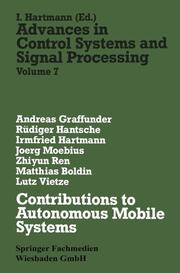-
Zusatztext
-
Autonomous mobile systems (AMS) are systems capable of some mobility and equipped with advanced sensor devices in order to flexibly respond to changing environmental situations, thus achieving some degree of autonomy. The purpose of this book is to contribute to some essential topics in this broad research area related to sensing and control, but not to present a complete design of an AMS. Subjects conceming knowledge based control and decision, such as moving around obstacles, task planning and diagnosis are left for future publications in this series. Research in the area of AMS has grown rapidly during the last decade, see e.g. [WAXMAN et al. 87], [DICKMANNS, ZAPP 87]. The requirements of an AMS strongly depends on the desired tasks the system should execute, its operational environment and the expected speed of the AMS. For instance, road vehicles obtain velocities of 10 m/s and more, therefore the processing of sensor data such as video image sequences has to be very fast and simple, while indoor mobile robots deal with shorter distances and lower speeds, thus more sophistcated techniques are applicable and -as is done in our approach- additional sensors can be integrated to allow for multi sensor processing.
-
-
Autorenportrait
- Inhaltsangabe1 Introduction.- 2 Modeling and Control of Robotic Manipulators.- 2.1 Modeling of robotic manipulators.- 2.2 Control of robotic manipulators in joint space.- 2.3 Control of robotic manipulators in cartesian space.- 2.4 Force control of robotic manipulators.- 2.5 References.- 3 Estimation of Structure and Relative Motion from Stereo Image Sequences.- 3.1 Introduction.- 3.2 Problem statement.- 3.3 Kinematics of relative point-movements.- 3.4 Representation of relative pose and object-structure.- 3.5 Processing stereo images.- 3.6 Estimation process.- 3.7 Results.- 3.8 References.- Appendix A: Proof of elementary theorems.- Appendix B: Representation of rotations by unit quaternions.- Appendix C: Algorithm for stereo matching by 3D-line segment chaining.- 4 Dynamic 3D Vision: The Visually Controlled Robot.- 4.1 Introduction.- 4.2 Statement of the problem.- 4.3 Theory of relative pose control.- 4.4 Results.- 4.5 References.- 5 Endeffector Force Approximation.- 5.1 Introduction.- 5.2 Observers for endeffector forces.- 5.3 Nonlinear state space observation.- 5.4 Approximative endeffector force observation.- 5.5 Conclusions.- 5.6 References.- 6 Ultrasonic Modeling.- 6.1 Foundations of industrial airborne ultrasonic modeling.- 6.2 Airborne ultrasonic phased-arrays.- 6.3 Ultrasonic environment modeling for mobile robots.- 6.3.1 Modeling using an phased-array-sensor.- 6.3.2 Modeling by different time of flight measurements.- 6.4 Experimental results.- 6.4.1 Results with the phased-array.- 6.4.2 Results with the time of flight measurements.- 6.5 References.- 7 Lane Recognition and Following.- 7.1 Introduction.- 7.2 Indirect edge detection by texture analysis.- 7.2.1 Feature extraction.- 7.2.2 Classification.- 7.2.3 Results.- 7.3 Direct edge detection, the PDAF.- 7.3.1 The PDAF-algorithm.- 7.3.2 Adaption to the practical situation.- 7.3.3 Results.- 7.3.4 Extension of the approach.- 7.4 References.- 8 Concept of a Multi-Transputer-System and its Application to Parallel Processing.- 8.1 Introduction.- 8.2 Requirements of an AMS's appropriate computer architecture.- 8.3 Key issues of parallel processing and architectural models.- 8.3.1 The level of concurrency.- 8.3.2 Partitioning.- 8.3.3 Scheduling.- 8.3.4 Synchronization and communication.- 8.3.5 Memory access and organization.- 8.3.6 Configuration and power of processing elements.- 8.3.7 Review of a few architectural concepts.- 8.4 The Transputer as a building block for a multiprocessor-system.- 8.5 Applications and programming hints.- 8.5.1 Speedup investigation concerning an implemented image processing algorithm.- 8.5.2 PDAF implementation.- 8.5.3 Obstacle detection by using image sequences.- 8.6 References.
Detailansicht
Contributions to Autonomous Mobile Systems
Advances in Control Systems and Signal Processing 7
Graffunder, Andreas/Hantsche, Rüdiger/Hartmann, Irmfried et al
ISBN/EAN: 9783528063832
Umbreit-Nr.: 5968452
Sprache:
Englisch
Umfang: vi, 174 S., 66 s/w Illustr.
Format in cm:
Einband:
kartoniertes Buch
Erschienen am 01.01.1992
Auflage: 1/1992


